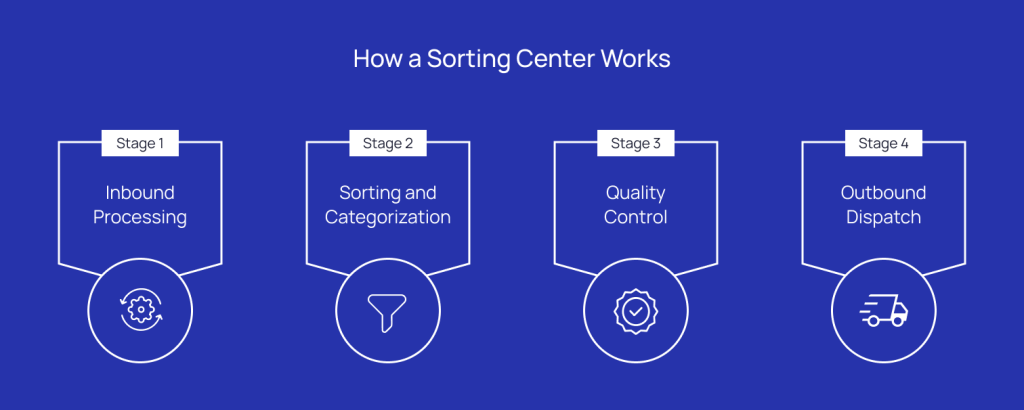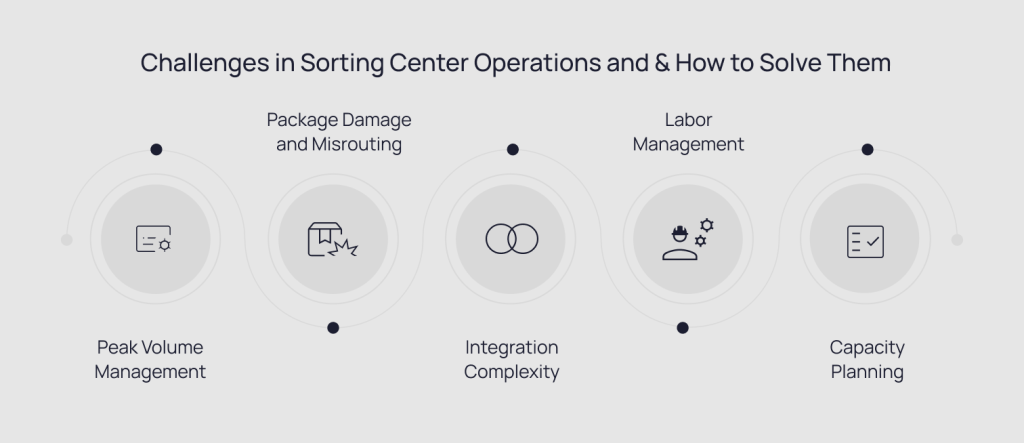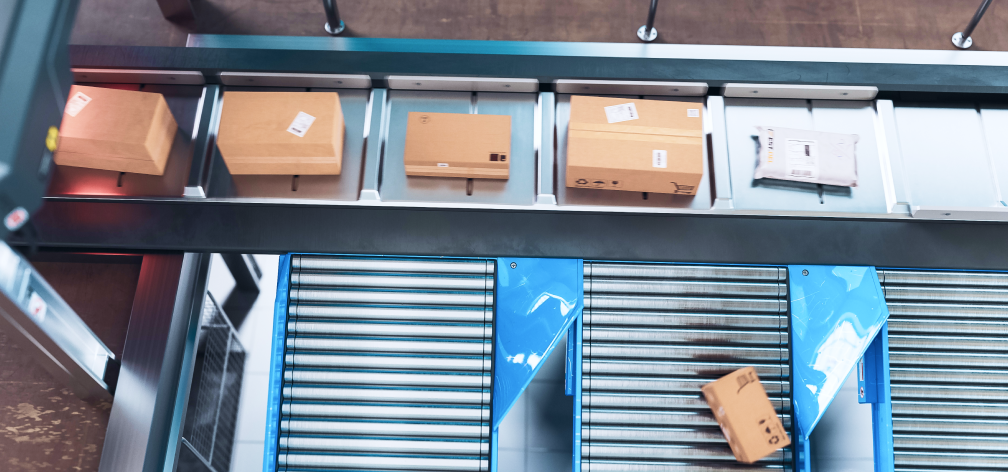Sorting Centers Explained: Role in E-commerce and Logistics
Blogs
Picture this: Your customer places an order at 2 PM expecting next-day delivery. By 6 PM, that package has traveled through multiple facilities, been sorted alongside thousands of others, and is already loaded onto a delivery truck heading to their neighborhood. What is it that makes this lightning-fast fulfillment possible? The answer is sorting centers.
While customers see only the start and end of their delivery journey, sorting centers operate as the critical nerve centers that make modern e-commerce logistics possible. These facilities orchestrate the complex choreography of getting millions of items to the right place, at the right time, every single day.
In this blog, we will explore what goes on in sorting centers, how they function within your logistics network, and why they’re becoming indispensable for businesses looking to meet today’s delivery expectations.
Key Takeaways:
- See how sorting centers make fast, accurate delivery possible at scale.
- Follow the step-by-step process from inbound scanning to outbound dispatch.
- Understand the unique role sorting centers play compared to warehouses and fulfillment centers.
- Discover the tech innovations that improve speed, accuracy, and efficiency.
- Learn how brands use sorting centers to cut costs and expand delivery coverage.
What is a Sorting Center?
A sorting center is a specialized logistics facility designed to receive, categorize, and redirect packages and shipments to their next destination in the supply chain. Unlike warehouses that store inventory or fulfillment centers that pick and pack orders, sorting centers focus purely on the rapid processing and routing of already-packaged items.
Think of a sorting center as the logistics equivalent of a major airport hub. Just as flights from various origins converge at a hub before being redistributed to their final destinations, packages from multiple sources flow into sorting centers where they’re systematically organized and dispatched based on delivery routes, shipping methods, and destination zones.
The primary function revolves around three core activities: receiving inbound packages from various sources, sorting them according to predetermined criteria (destination, shipping speed, carrier), and dispatching them to the appropriate outbound routes. Modern sorting centers can process tens of thousands of packages per hour.
How a Sorting Center Works
The sorting center operation follows a carefully orchestrated workflow that maximizes speed while maintaining accuracy. Understanding this process helps explain why these facilities are so crucial for your logistics strategy.

Stage 1: Inbound Processing
The process begins when packages arrive from fulfillment centers, retail stores, or other sorting facilities. Each package is scanned to capture tracking information and verify its destination. This inbound sorting center phase is critical. It’s where packages enter the sorting network and begin their journey toward the customer.
Stage 2: Sorting and Categorization
Packages then move through automated or semi-automated sorting systems. High-volume facilities use conveyor belts with barcode scanners and sorting machines that can read addresses and routing information. Packages are diverted into different chutes or areas based on factors like ZIP codes, delivery routes, shipping speed (standard vs. express), and carrier assignments.
Stage 3: Quality Control
Throughout the process, quality checkpoints ensure packages are routed correctly. Damaged items are flagged for special handling, and any scanning errors are caught and corrected.
Stage 4: Outbound Dispatch
Finally, sorted packages are loaded onto delivery trucks, shipped to regional distribution centers, or transferred to carrier networks. The timing of these dispatches is carefully coordinated with delivery schedules and transportation capacity.
Modern sorting centers often operate on tight schedules with many running multiple sorts per day to accommodate different shipping speeds and delivery windows. An express package might be processed and dispatched within hours, while standard shipments might wait for the next scheduled sort.
Sorting Center vs Fulfillment Center vs Distribution Center
While these terms are often used interchangeably, each facility type serves distinct functions in your logistics network, and understanding these differences is crucial for optimizing your supply chain strategy.
| Facility Type | Primary Function | Key Activities | Inventory Storage |
| Sorting Center | Route packages to destinations | Receive, sort, dispatch | Minimal (transit only) |
| Fulfillment Center | Process customer orders | Pick, pack, ship orders | Yes (active inventory) |
| Distribution Center | Store and distribute inventory | Receive, store, fulfill bulk orders | Yes (large-scale storage) |
Fulfillment Centers are where your inventory lives and customer orders are processed. They’re equipped with storage systems, picking zones, packing stations, and often integrate with warehouse management systems to optimize order processing. When a customer places an order, it’s fulfilled from these centers.
Distribution Centers operate at a larger scale, typically serving as regional hubs that supply multiple fulfillment centers or retail locations. They focus on bulk inventory management and B2B distribution rather than individual customer orders.
Sorting Centers bridge the gap between fulfillment and delivery. They don’t store inventory long-term but instead focus on the rapid processing and routing of packages that are already on their way to customers. This specialization allows them to achieve the speed and efficiency that modern delivery expectations demand.
The Strategic Role of Sorting Centers in E-commerce and 3PL Logistics
Sorting centers have progressed from basic package routing facilities to strategic logistics assets that directly influence delivery performance. Many have adopted high-speed automated systems [1] to boost throughput and accuracy, reinforcing their role in driving operational excellence. More than just logistical nodes, they play a vital role in enhancing customer satisfaction and strengthening competitive positioning.
For e-commerce businesses, sorting centers solve the “last-mile puzzle” by creating efficient pathways between fulfillment and delivery. They allow you to consolidate packages from multiple fulfillment centers, optimize delivery routes, and reduce the number of touch points each package requires before reaching the customer.
In the 3PL (Third-Party Logistics) ecosystem, sorting centers provide scalability without the overhead of additional fulfillment infrastructure. Instead of building more fulfillment centers to serve new regions, businesses can leverage sorting centers to extend their delivery reach and improve delivery times to previously challenging markets.
The strategic value becomes especially apparent during peak seasons. While fulfillment centers might become bottlenecked during high-volume periods, sorting centers can process the increased throughput by optimizing routes and coordinating with multiple carriers simultaneously.
Benefits of Using Sorting Centers
The advantages of incorporating sorting centers into your logistics network extend across multiple dimensions of your business operations.
1. Improved Delivery Speed
By optimizing package routing and reducing unnecessary transit steps, sorting centers can significantly reduce delivery time. Packages take more direct routes to their destinations, and the consolidation of shipments allows for more frequent dispatches.
2. Cost Optimization
Sorting centers enable economies of scale in transportation. Instead of sending partially filled trucks to multiple destinations, packages are consolidated into fuller loads, reducing per-package transportation costs. This consolidation also means fewer vehicles on the road and reduced fuel consumption.
3. Enhanced Delivery Accuracy
The systematic sorting process, often supported by automated scanning and tracking systems, dramatically reduces misrouted packages. This accuracy translates directly into better customer satisfaction and fewer costly delivery exceptions.
4. Operational Flexibility
Sorting centers provide buffer capacity during demand spikes and can redirect packages to alternative routes when disruptions occur. This flexibility is crucial for maintaining service levels during peak seasons or unexpected events.
5. Regional Coverage Expansion
Rather than building fulfillment infrastructure in every market you want to serve, sorting centers allow you to extend delivery coverage economically. You can serve new regions with faster delivery time without capital investment in new fulfillment centers.

How Sorting Centers Support Last-Mile Optimization
The final leg or ‘last-mile’ of delivery represents up to half of the total cost [2] and the most critical part of the delivery journey. Sorting centers play a pivotal role in optimizing this crucial phase.
By strategically positioning sorting centers closer to population centers, businesses can reduce the distance packages travel during last-mile delivery. This proximity translates into faster delivery times, lower transportation costs, and reduced environmental impact.
Sorting centers also enable route optimization at scale. Instead of individual delivery vehicles starting from distant fulfillment centers with mixed loads, they can begin their routes from nearby sorting centers with packages already organized by delivery zones. This organization allows drivers to complete more deliveries per route and reduces the time between stops.
The coordination capabilities of sorting centers extend to working with multiple delivery partners simultaneously. A single facility might route packages through traditional carriers, local couriers, or crowdsourced delivery platforms. The choice depends on which option is most efficient for each shipment, based on destination, timing, and cost.
Technologies Powering Modern Sorting Centers
Today’s sorting centers rely on sophisticated technology to achieve the speed and accuracy that modern logistics demands. These technologies transform what was once a manual, labor-intensive process into a highly automated, data-driven operation.
1. Automated Sorting Systems
Modern facilities use conveyor systems equipped with barcode and RFID scanners that can read package information and automatically route items to the correct destination chutes. These systems can process thousands of packages per hour with minimal human intervention.
2. Warehouse Management Systems
Advanced warehouse management systems coordinate the entire sorting operation, from inbound receiving to outbound dispatch. These systems track package locations in real-time, optimize sorting sequences, and coordinate with transportation management systems.
3. Machine Learning and AI
Predictive algorithms help optimize sorting sequences and route planning. Machine learning systems can predict package volumes, identify potential bottlenecks, and automatically adjust operations to maintain efficiency.
4. Real-Time Tracking Systems
IoT sensors and GPS tracking provide visibility into package location and status throughout the sorting process. This visibility enables proactive exception handling and provides customers with accurate delivery updates.
5. Robotics
Advanced facilities are incorporating robotic systems for package handling, reducing labor requirements and increasing processing speed. These robots can work alongside human operators to handle packages that require special attention.
Challenges in Sorting Center Operations and How to Solve Them
Despite their sophisticated operations, sorting centers face several operational challenges that can impact performance and efficiency.

1. Peak Volume Management
Seasonal spikes and promotional events can overwhelm sorting capacity, leading to delays and bottlenecks. Solutions include implementing flexible staffing models, using predictive analytics to anticipate volume surges, and developing overflow protocols that can redirect packages to alternative facilities.
2. Package Damage and Misrouting
High-speed automated systems can sometimes mishandle packages or route them incorrectly. Investing in quality sorting equipment, implementing multiple scanning checkpoints, and maintaining rigorous quality control processes help minimize these issues.
3. Integration Complexity
Sorting centers must integrate with multiple carriers, fulfillment systems, and tracking platforms. Robust integration platforms and standardized data formats help manage this complexity and ensure seamless information flow.
4. Labor Management
Balancing automation with human oversight requires careful workforce planning. Cross-training employees, implementing flexible scheduling, and focusing human efforts on exception handling and quality control optimize labor efficiency.
5. Capacity Planning
Accurately forecasting capacity needs and expansion requirements requires sophisticated planning. Regular capacity assessments, scalable infrastructure design, and strategic partnerships help ensure sorting centers can handle growth.
Sorting Center Strategies Brands are Using to Scale
These are the key strategies brands across different business models and industries are employing to leverage the strategic value of sorting centers.
1. Unified Delivery Across Channels
Companies selling through both online and physical channels use sorting centers to consolidate shipments from various fulfillment points. This consolidation enables them to offer consistent delivery speeds across all channels while optimizing transportation costs.
2. Route Optimization for Recurring Shipments
Businesses with recurring shipments leverage sorting centers to optimize recurring delivery routes. By batching subscription shipments and coordinating delivery schedules, they achieve significant cost savings while maintaining delivery reliability.
3. Agile Market Entry for Global Growth
Companies expanding into new geographic markets use sorting centers as their starting base that enable faster delivery time without the commitment of full fulfillment infrastructure. This approach allows for market testing and gradual expansion with lower risk.
For businesses transitioning from B2B to B2C operations, sorting centers can also provide the flexibility needed for B2C fulfillment without completely restructuring existing logistics networks.

Conclusion
Sorting centers represent more than just another node in your logistics network, they’re also strategic enablers of customer satisfaction and competitive advantage. As delivery expectations continue to rise and e-commerce volumes grow, the role of these facilities in connecting fulfillment to final delivery becomes increasingly critical.
The businesses that thrive in today’s competitive reality are those that understand how to leverage sorting centers not just for operational efficiency, but as tools for market expansion, cost optimization, and customer experience enhancement. Whether you’re looking to improve delivery time, reduce logistics costs, or expand into new markets, sorting centers offer a path to achieve these goals without the massive capital investment traditional logistics expansion requires.
The integration of advanced technologies, from warehouse automation to AI-powered optimization, continues to enhance the capabilities of these facilities, making them even more valuable as strategic assets.
Ready to optimize your logistics network with intelligent sorting center strategies?
Get in touch with our experts today to discover how Anchanto WMS can transform your delivery performance and drive business growth.
FAQs
1. What is a sorting center and how does it differ from a warehouse?
A sorting center is a specialized facility focused on receiving, categorizing, and redirecting packages to their next destination, while warehouses primarily store inventory for extended periods. Sorting centers emphasize speed and routing efficiency, processing packages within hours rather than storing them long-term.
2. How does inbound in sorting center processing work?
Inbound sorting center operations begin when packages arrive from fulfillment centers or other facilities. Each package is scanned to capture tracking information, verified for destination accuracy, and then enters the sorting workflow where it’s categorized and routed based on delivery zones, shipping speed, and carrier assignments.
3. What is the main purpose of a sorting center in e-commerce logistics?
The main purpose is to optimize package routing between fulfillment and final delivery, enabling faster delivery times, reduced transportation costs, and improved delivery accuracy. Sorting centers act as strategic hubs that consolidate shipments and create efficient pathways to customers.
4. How do sorting centers improve last-mile delivery efficiency?
Sorting centers enhance last-mile efficiency by positioning packages closer to their final destinations, organizing them by delivery routes, and coordinating with multiple carriers. This organization reduces travel distances, enables route optimization, and allows delivery vehicles to start with pre-sorted loads.
5. What technologies are essential for modern sorting center operations?
Essential technologies include automated conveyor systems with barcode scanning, warehouse management systems for coordination, machine learning for predictive optimization, real-time tracking systems, and increasingly, robotics for package handling. These technologies enable high-speed processing while maintaining accuracy.
References:
[1] Marketsandata.com – Global Automated Sorting Systems Market Assessment
